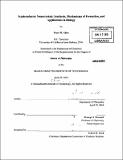Semiconductor nanocrystals : synthesis, mechanisms of formation, and applications in biology
Author(s)
Allen, Peter M. (Peter Matthew)
DownloadFull printable version (11.08Mb)
Other Contributors
Massachusetts Institute of Technology. Dept. of Chemistry.
Advisor
Moungi G. Bawendi.
Terms of use
Metadata
Show full item recordAbstract
The primary focus of this thesis is the synthesis and applications of semiconductor nanocrystals, or quantum dots (QDs). Novel synthetic routes to ternary 1-III-VI QDs are presented, and we report the first highly luminescent Cu-In-Se QDs spanning the red to near-infrared region. The synthetic method is modular and is extended to Ag-In-Se, Cu-In-Zn-S, and Ag-In-Zn-S QDs, luminescent from the blue to near-infrared. The development of new core-shell InAs(ZnCdS) QDs is discussed in the context of making highly fluorescent, stable biological probes in the near-infrared region. Applications in biological systems from cellular labeling to sentinel lymph node mapping are demonstrated. In addition, we present new methods for doping InAs QDs in order to control carrier type through the introduction of acceptor defects such as cadmium. The synthesis and characterization of n and p type InAs QDs is discussed. In order to understand the differences in size distributions with current III-V QD synthetic procedures and II-VI and IV-VI QD syntheses we have explored the molecular mechanisms that lead to the formation of InP and InAs QDs. We find that current III-V QD syntheses result in the depletion of molecular precursors immediately following nucleation, preventing growth from molecular precursors, thus failing to meet the a key criterion for a monodisperse colloidal synthesis in the Dinegar and LaMer model. In the conclusion of this thesis, we explore the electrically controlled solution-liquid-solid (EC-SLS) synthesis of InP nanowires. Using the EC-SLS method, we are able to controllably place n type InP nanowires into field effect transistor geometries.
Description
Thesis (Ph. D.)--Massachusetts Institute of Technology, Dept. of Chemistry, 2010. "April 29, 2010." Vita. Cataloged from PDF version of thesis. Includes bibliographical references.
Date issued
2010Department
Massachusetts Institute of Technology. Department of ChemistryPublisher
Massachusetts Institute of Technology
Keywords
Chemistry.